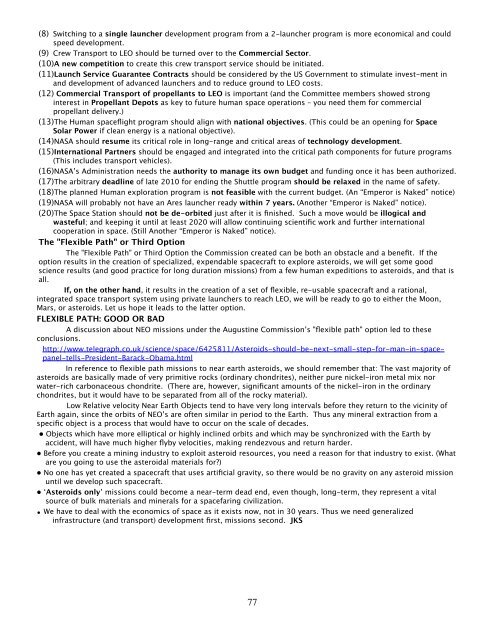Space Transportation - mmmt_transportation.pdf - Moon Society
Space Transportation - mmmt_transportation.pdf - Moon Society
Space Transportation - mmmt_transportation.pdf - Moon Society
You also want an ePaper? Increase the reach of your titles
YUMPU automatically turns print PDFs into web optimized ePapers that Google loves.
(8) Switching to a single launcher development program from a 2-launcher program is more economical and could<br />
speed development.<br />
(9) Crew Transport to LEO should be turned over to the Commercial Sector.<br />
(10)A new competition to create this crew transport service should be initiated.<br />
(11)Launch Service Guarantee Contracts should be considered by the US Government to stimulate invest-ment in<br />
and development of advanced launchers and to reduce ground to LEO costs.<br />
(12) Commercial Transport of propellants to LEO is important (and the Committee members showed strong<br />
interest in Propellant Depots as key to future human space operations – you need them for commercial<br />
propellant delivery.)<br />
(13)The Human spaceflight program should align with national objectives. (This could be an opening for <strong>Space</strong><br />
Solar Power if clean energy is a national objective).<br />
(14)NASA should resume its critical role in long-range and critical areas of technology development.<br />
(15)International Partners should be engaged and integrated into the critical path components for future programs<br />
(This includes transport vehicles).<br />
(16)NASA’s Administration needs the authority to manage its own budget and funding once it has been authorized.<br />
(17)The arbitrary deadline of late 2010 for ending the Shuttle program should be relaxed in the name of safety.<br />
(18)The planned Human exploration program is not feasible with the current budget. (An “Emperor is Naked” notice)<br />
(19)NASA will probably not have an Ares launcher ready within 7 years. (Another “Emperor is Naked” notice).<br />
(20)The <strong>Space</strong> Station should not be de-orbited just after it is finished. Such a move would be illogical and<br />
wasteful; and keeping it until at least 2020 will allow continuing scientific work and further international<br />
cooperation in space. (Still Another “Emperor is Naked” notice).<br />
The "Flexible Path" or Third Option<br />
The "Flexible Path" or Third Option the Commission created can be both an obstacle and a benefit. If the<br />
option results in the creation of specialized, expendable spacecraft to explore asteroids, we will get some good<br />
science results (and good practice for long duration missions) from a few human expeditions to asteroids, and that is<br />
all.<br />
If, on the other hand, it results in the creation of a set of flexible, re-usable spacecraft and a rational,<br />
integrated space transport system using private launchers to reach LEO, we will be ready to go to either the <strong>Moon</strong>,<br />
Mars, or asteroids. Let us hope it leads to the latter option.<br />
FLEXIBLE PATH: GOOD OR BAD<br />
A discussion about NEO missions under the Augustine Commission’s "flexible path" option led to these<br />
conclusions.<br />
http://www.telegraph.co.uk/science/space/6425811/Asteroids-should-be-next-small-step-for-man-in-spacepanel-tells-President-Barack-Obama.html<br />
In reference to flexible path missions to near earth asteroids, we should remember that: The vast majority of<br />
asteroids are basically made of very primitive rocks (ordinary chondrites), neither pure nickel-iron metal mix nor<br />
water-rich carbonaceous chondrite. (There are, however, significant amounts of the nickel-iron in the ordinary<br />
chondrites, but it would have to be separated from all of the rocky material).<br />
Low Relative velocity Near Earth Objects tend to have very long intervals before they return to the vicinity of<br />
Earth again, since the orbits of NEO’s are often similar in period to the Earth. Thus any mineral extraction from a<br />
specific object is a process that would have to occur on the scale of decades.<br />
• Objects which have more elliptical or highly inclined orbits and which may be synchronized with the Earth by<br />
accident, will have much higher flyby velocities, making rendezvous and return harder.<br />
• Before you create a mining industry to exploit asteroid resources, you need a reason for that industry to exist. (What<br />
are you going to use the asteroidal materials for?)<br />
• No one has yet created a spacecraft that uses artificial gravity, so there would be no gravity on any asteroid mission<br />
until we develop such spacecraft.<br />
• ‘Asteroids only’ missions could become a near-term dead end, even though, long-term, they represent a vital<br />
source of bulk materials and minerals for a spacefaring civilization.<br />
• We have to deal with the economics of space as it exists now, not in 30 years. Thus we need generalized<br />
infrastructure (and transport) development first, missions second. JKS<br />
77















